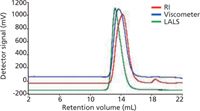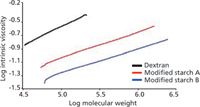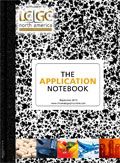Structural Differences in Modified Starches
The Application Notebook
Malvern Instruments Ltd.
Modified starches are important materials used in many applications including foodstuffs. The starches are modified by a number of methods — both physical and chemical — to tailor the properties to the required application. Most commonly the starches are modified to give a particular texture to a finished foodstuff; for example, to give extra thickening in puddings.
In this application note we show how two modified starch samples with essentially the same molecular size in solution can be easily differentiated and characterized by triple detection size-exclusion chromatography (TD-SEC).
Triple Detection SEC
In the advanced technique of TD-SEC, the sample, after separation on the chromatography column, is passed though a series of detectors to provide a complete analysis of the molecules: The low angle light scattering detector (LALS) provides a direct measure of the molecular weight; the refractive index (RI) detector measures the concentration; and the differential viscometer measures the intrinsic viscosity (IV). From the measured IV and molecular weight (MW) values a Mark-Houwink (M-H) plot showing structural changes can be made.
Instrumentation and Conditions
SEC system comprising the Viscotek GPCmax (degasser, pump, autosampler) with the Viscotek TDA detector equipped with the following detectors: Low angle light scattering; differential viscometer; RI. The data were all calculated using OmniSEC software.

Figure 1: Triple chromatogram of a modified starch sample.
Discussion
The triple chromatogram of one of the modified starch samples is shown in Figure 1. The signal-to-noise on all three detectors is excellent, which ensures the quality of the calculated data. The data are calculated directly from the chromatograms by the OmniSEC software and the results for both samples are shown in Table I. Note that the hydrodynamic radius (RH) of both samples is within 0.2 nm. This means that by traditional GPC/SEC techniques the molecular weights based on retention volumes would be the same. However, TD-SEC clearly shows the weight average molecular weight of sample A is only 60% of sample B. We can also see that the viscosity of A, despite the lower molecular weight, is higher than B.

Table I: Weight average molecular weight, number average molecular weight, intrinsic viscosity, and hydrodynamic radius data
By looking at the structure plot (M-H plot, Figure 2) of both modified samples (with a dextran T70 sample as reference), it is clear that the two modified starches have very different molecular structures. Sample B has a much more compact structure than sample A; shown by the fact it appears lower on the M-H plot. This means that despite higher molecular weight the molecules in sample B are denser — because of the different modification — resulting in a lower intrinsic viscosity. The dextran T70 material is shown for reference. It indicates, as expected, that modified starches have a much more compact structure than dextran.

Figure 2: Mark-Houwink (Structure) plot.
Conclusions
The Viscotek triple detection system provides a convenient and rapid way to characterize starches and modified starches. The instrument allows determination of molecular weight and molecular size in a single run using normal conditions and sample concentrations. The IV and size data allow differentiation between molecules of differing structures. The technique is equally applicable to other polysaccharides and all other synthetic or natural polymers such as proteins and DNA.

Malvern Instruments Ltd.
Enigma Business Park, Grovewood Road, Malvern, UK
tel. +44 (0) 1684 892456
E-mail: salesinfo@malvern.com
Website: www.malvern.com















